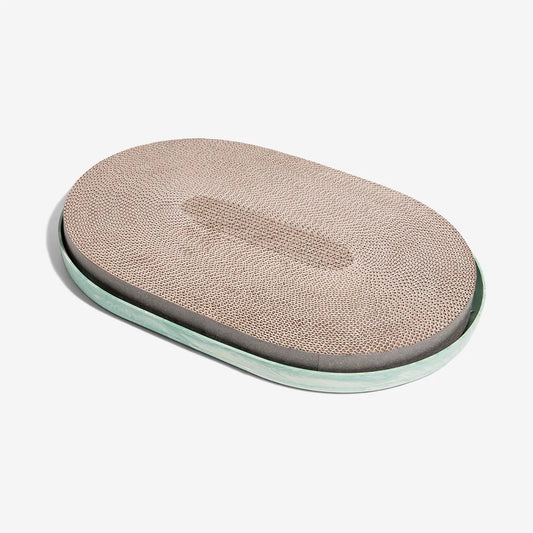Cats are wonderful pets that bring joy and companionship to their owners. However, their natural instinct to scratch can cause damage to furniture, carpets, and even their human companions. While declawing may seem like an easy solution, it is a painful and inhumane procedure that should be avoided. Fortunately, there are humane and effective ways to prevent cats from scratching inappropriately.
One way to stop cats from scratching is to provide them with appropriate scratching surfaces. Cats love to scratch on rough surfaces like tree bark and sisal rope, so providing a scratching post or pad made of these materials can redirect their scratching behavior. It's important to place the scratching surface in a location that the cat likes to scratch, such as near their favorite sleeping spot or in a high-traffic area of the house.
Another way to prevent scratching is to discourage cats from scratching in inappropriate areas. This can be done by using deterrents such as double-sided tape, aluminum foil, or citrus sprays on the furniture or carpet. These deterrents are unpleasant for cats to scratch on and can help redirect their behavior to the appropriate scratching surface. With patience and consistency, cats can learn to scratch in appropriate areas and live peacefully with their human companions.
Understanding Cat Behavior
Cats are natural scratchers, and it is essential to understand why they do it to prevent them from damaging your furniture, carpet, and even you. Understanding cat behavior is crucial to help you train your cat to scratch in appropriate places.
Reasons for Scratching
Scratching is a natural behavior for cats, and there are several reasons why they do it. These include:
-
Marking their territory: Cats have scent glands in their paws, and scratching leaves their scent on the object they scratch. This helps them mark their territory and feel more secure.
-
Stretching and exercising: Scratching helps cats stretch and exercise their muscles, keeping them healthy and agile.
-
Sharpening their claws: Scratching helps cats remove the outer layer of their claws, keeping them sharp and healthy.
Scratching as Natural Instinct
Scratching is a natural instinct for cats, and it is essential to provide them with appropriate places to scratch. If you don't provide your cat with a scratching post or other appropriate scratching surface, they will find something else to scratch, such as your furniture or carpet.
To prevent your cat from scratching in inappropriate places, it is crucial to provide them with a scratching post or other appropriate scratching surface. You can also discourage them from scratching in inappropriate places by using deterrents such as double-sided tape or aluminum foil.
In conclusion, understanding cat behavior is crucial to prevent them from scratching your furniture, carpet, and you. Providing your cat with appropriate scratching surfaces and using deterrents can help train your cat to scratch in appropriate places.
Effective Deterrents and Solutions
Cats love to scratch, and their claws can wreak havoc on furniture, carpet, and even their owners. However, there are several effective deterrents and solutions that can help prevent unwanted scratching and keep both your cat and your home happy.
Scratch-Proofing Your Furniture
One of the most effective ways to prevent furniture scratching is to make it unappealing to your cat. Covering your furniture with materials that cats dislike can help deter them from scratching. Materials such as aluminum foil, double-sided tape, or sandpaper can be used to protect your furniture from scratches.
Another solution is to invest in scratch-proof furniture covers or slipcovers that can be easily removed and washed. These covers can protect your furniture from scratches while also providing a comfortable place for your cat to nap.
Training Your Cat with Positive Reinforcement
Training your cat to scratch in designated areas can be an effective way to prevent unwanted scratching. Positive reinforcement training involves rewarding your cat for using a scratching post or designated scratching area.
To train your cat, place a scratching post or designated scratching area near your cat's favorite resting spot. Encourage your cat to use the scratching post by placing treats or toys near it. When your cat uses the scratching post, reward them with praise and treats.
Providing Alternatives
Providing your cat with alternative scratching surfaces can also help prevent unwanted scratching. Scratching posts, pads, and mats are all great options for providing your cat with a designated scratching area.
When choosing a scratching post, make sure it is tall enough for your cat to stretch out and sturdy enough to withstand scratching. Placing the scratching post in a prominent location can also encourage your cat to use it.
Using Repellents and Deterrents
Repellents and deterrents can be used to discourage your cat from scratching in unwanted areas. Citrus sprays, double-sided tape, and motion-activated deterrents can all be used to discourage your cat from scratching furniture and other surfaces.
It is important to note that some cats may be deterred by certain repellents and not others. Experimenting with different types of repellents can help you find the one that works best for your cat.
Addressing Unwanted Scratching
If your cat continues to scratch in unwanted areas, it may be a sign of an underlying issue such as stress or anxiety. Addressing these underlying issues can help prevent unwanted scratching.
Providing your cat with plenty of playtime, exercise, and mental stimulation can help reduce stress and anxiety. If your cat continues to scratch in unwanted areas despite your best efforts, consult with your veterinarian to rule out any underlying medical conditions.

























